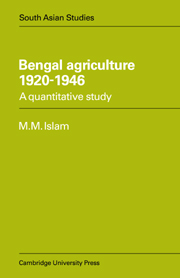Book contents
- Frontmatter
- Contents
- List of tables
- List of figures
- Foreword
- Preface
- Introduction
- PART ONE
- PART TWO
- 4 Price elasticity of acreage under cultivation
- 5 Capital in agriculture
- 6 Agricultural credit and the Co-operative Credit Movement
- 7 Bengal landlords and agriculture
- Conclusion
- Appendix: statistical tables
- Select bibliography
- Index
6 - Agricultural credit and the Co-operative Credit Movement
from PART TWO
Published online by Cambridge University Press: 15 December 2009
- Frontmatter
- Contents
- List of tables
- List of figures
- Foreword
- Preface
- Introduction
- PART ONE
- PART TWO
- 4 Price elasticity of acreage under cultivation
- 5 Capital in agriculture
- 6 Agricultural credit and the Co-operative Credit Movement
- 7 Bengal landlords and agriculture
- Conclusion
- Appendix: statistical tables
- Select bibliography
- Index
Summary
The purpose of the present chapter is to evaluate the performance of the Co-operative Credit Movement during the period under review (1920–47). However, in order to place the movement in its proper perspective, we start with a brief reference to some general issues related to agricultural credit. Finally, the opinions of some individual authors and committees of enquiry about the limited success of the Co-operative Credit Movement are briefly reviewed.
THE GENERAL BACKGROUND
A proper system of credit is of as basic importance to agriculture as it is to industry. But agriculture has certain distinctive features which place it in a disadvantageous position as against industry in respect of the availability of finance from the usual credit agencies. First of all, the scale of production in agriculture is small. ‘While other industries tend to become concentrated in units of ever increasing size, agriculture remains scattered, individualistic, small-scale and chaotic.’ The problem is further complicated by the simultaneous presence of production for domestic consumption and the market. In these conditions a large part of the working capital which the cultivators need has the character of being related to their consumption rather than to production. Secondly, the risks and uncertainties involved in agricultural production are greater than in manufacturing industry, as success in agriculture depends on factors outside the control of the cultivators. A third distinctive feature of agriculture is that agricultural products are often perishable or of such a nature that they cannot be properly stored. Lastly, agricultural production involves a longer time scale than does industrial production – sometimes the cultivators have to wait a year for their harvests.
- Type
- Chapter
- Information
- Bengal Agriculture 1920–1946A Quantitative Study, pp. 157 - 183Publisher: Cambridge University PressPrint publication year: 1979



